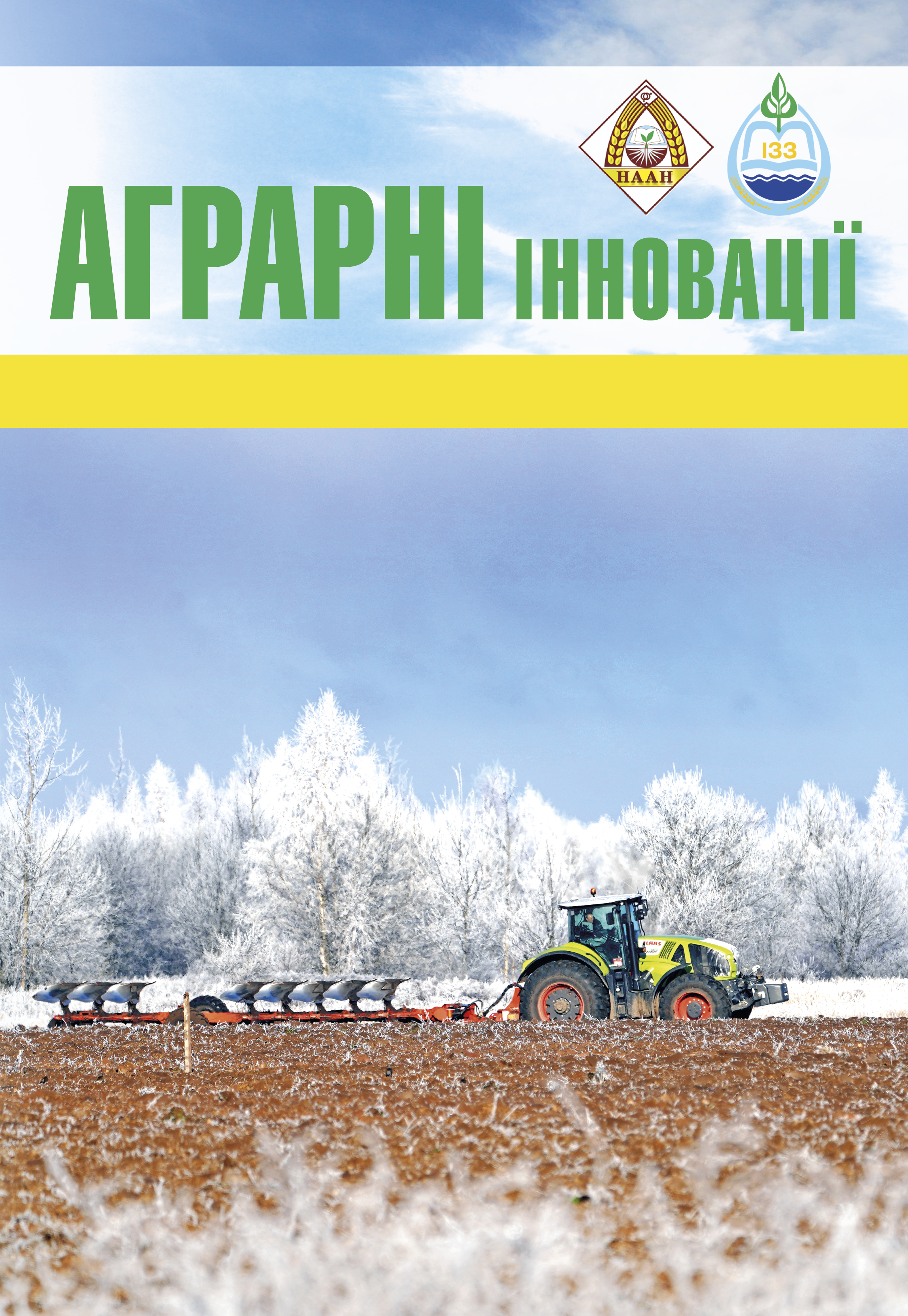Potential weed infestation of winter rye depending on predecessors and soil tillage methods
Abstract
Goal. This study aimed to conduct herbological monitoring of winter rye under the influence of different predecessors (sunflower and safflower) and soil tillage methods. Methods. Field, statistical, comparative. Results. The article presents the results of potential soil weed infestation before sowing winter rye and data from the main inspection of winter rye crops during the milky-wax ripeness stage under the influence of various predecessors and soil tillage methods. The study utilized the variety «Khamarka». It was found that potential weed infestation after sunflower as a predecessor was twice lower compared to safflower as a predecessor under chisel tillage at different depths. Regarding the main inspection of winter rye crops, a fourfold decrease in weed infestation after sunflower as a predecessor and a threefold decrease after safflower were recorded compared to the data on potential weed infestation. During the monitoring of potential weed infestation and the main inspection, up to 10 weed species were identified. Perennial weeds predominantly included species such as Taraxacum officinale, Convolvulus arvensis, Sonchus arvensis, and Elymus repens. Among annual weeds, the most common were Amaranthus retroflexus, Thlaspi arvense, Setaria pumila, Sinapis arvensis, and Ambrosia artemisiifolia. Conclusions. The main inspection of winter rye revealed a decrease in weed infestation without the use of chemical methods for controlling weed population, resulting in a threefold reduction in weed infestation. This suggests that winter rye plays a role in reducing the negative impact of weed infestation and decreasing the overall population and species composition of weed vegetation.
References
2. Kunah O. M., Pakhomov O. Y., Zymaroieva А. А., Demchuk N. I., Skupskyi R. et al. Agroeconomic and agroecological aspects of spatial variation of rye (Secale cereale) yields within Polesia and the Forest-Steppe zone of Ukraine: The usage of geographically weighted principal components analysis. Biosystems Diversity. 2018. № 26(4). Р. 276–285. doi:10.15421/011842
3. Конопля M. І., Курдюкова О. М., Мельник Н. О. Забур’яненість агрофітоценозів як екологічна проблема землеробства. Фальцфейнівські читання. Збірник наукових праць. С. 157–161.
4. Грицюк Н. та ін. Вплив обробітку ґрунту на забур’яненість посівів озимої пшениці в умовах Українського Полісся. Наукові обрії. № 5. 2020. С. 15–21. doi: 10.33249/2663-2144-2020-90-5-15-21
5. Rahman M. M. Weed management in conservation agriculture. Advances in Plants &Agriculture Research. № 7 (3). 2017. Р. 301–302. doi: 10.15406/apar.2017.07.00257.
6. Bakalova А. V., Hrytsiuk N. V., Stoliar S. H., & Tkalenko N. М. Special aspects of thedevelopment of black currant bushes depending on weediness level in the Ukrainian Рolissia. Ukrainian Journal of Ecology, 10 (4). 2020. 18–22. doi: 10.15421/2020_161
7. Фурманець М. Г., Фурманець Ю. С. Вплив систем обробітку грунту та удобрення із використанням побічної продукції та продуктивність пшениці озимої в Західному Поліссі України. Збірник наукових праць Уманського НУС. Вип. 98 (1). 2021. С. 239–246. doi: 10.31395/2415-8240-2021-98-1-239-246
8. Кривенко А. І, Почколіна С. В., Безеде Н. Г. Видовий склад бур’янів та забур’яненість посівів пшениці озимої залежно від попередників та різних систем основного обробітку ґрунту в умовах Причорномор’я. Таврійський науковий вісник. № 108, 53–62. (2019). doi: 10.32851/2226-0099.2019.108.8
9. Будьонний В. Ю., Башкатова Г. М. Потенційна забур’яненість ґрунту під час вирощування жита озимого. Вісник Харківського національного аграрного університету. Серія «Рослинництво, селекція і насінництво, плодоовочівництво і зберігання». 2019. Вип.2. С. 123–132.
10. Омелюта В. П., Григорович І. В., Чабан В. С. Облік шкідників і хвороб сільськогосподарських культур / за ред. В. П. Омелюти. К.:Урожай, 1986. 286 с.
11. Поліщук В. О. Вплив органічних технологій на продуктивність та фітосанітарний стан жита озимого зони Полісся України. Карантин і захист рослин. №.9–10. 2018. С. 5–8.
12. Сторчоус І. Методи контролю бур’янів у посівах пшениці озимої. Пропозиція. № 1. С. 108–110.
13. Luna J. M., Mitchell J. P., Shrestha A. Conservation tillage for organic agriculture: Evolution toward hybrid systems in the western USA. Renew. Agric. Food Syst. № 27. Р. 21–30. doi: 10.1017/S1742170511000494.
14. Писаренко В. Система органічного землеробства агроеколога Семена Антонця. 2017.
15. Кравчук М. М. Забур’яненість та продуктивність посівів пшениці озимої залежно від агротехнологій з елементами біологізації в умовах Полісся. 2018. Наукові обрії. № 7–8 (70). С. 42–49. doi: 10.33249/2663-2144-2018-70-7-8-42-49
16. Вавринович О., Качмар О. Формування конкурентоспроможності пшениці озимої щодо бур’янів у короткоротаційних сівозмінах. Вісник Львівського національного аграрного університету. Агрономія. № 17 (2). 2013. С. 37–41.
17. Кравчук М. та ін. Забур’яненість посівів озимого жита залежно від способів обробітку ґрунту в умовах переходу на органічне землеробство. Наукові горизонти. № 1. 2020. С. 39–45. doi: 10.33249/2663-2144-2020-86-1-39-45.
18. Жито озиме Secale сereale L. Інститут ролинництва ім. В.Я. Юр’єва. Національної академії аграрних наук України. URL:https://yuriev.com.ua/ua/katalogprodukcii/katalog/zhito-ozime/hamarka/
19. Будьонний Ю.В. та ін. Практикум із загального і меліоративного землеробства. Харків: ХНАУ, 2005. 286 с.






